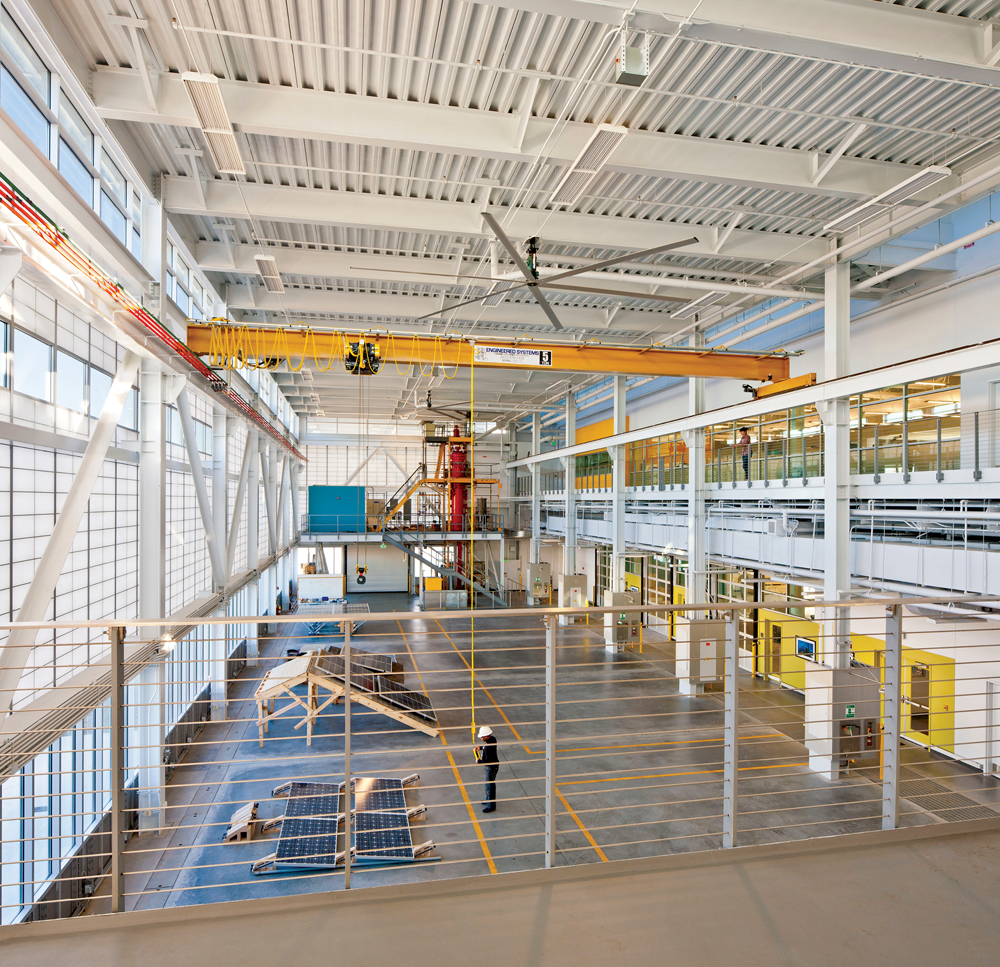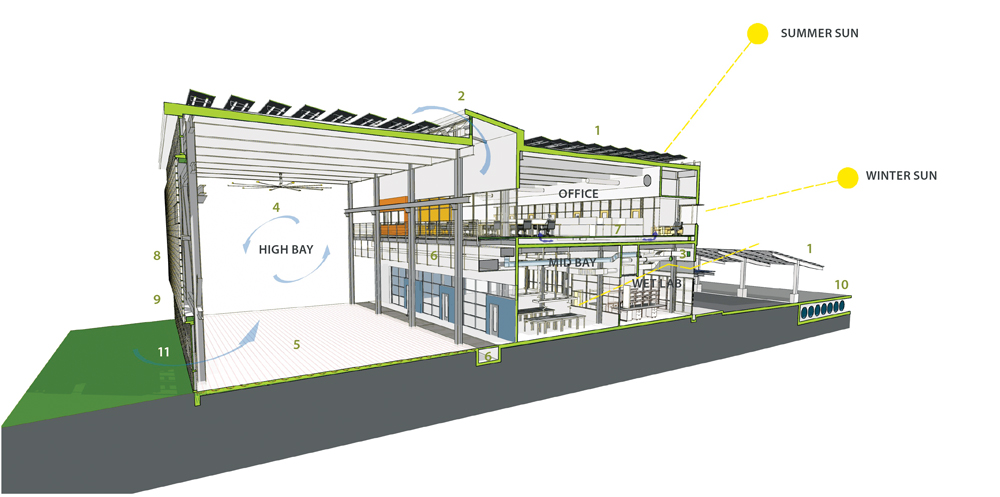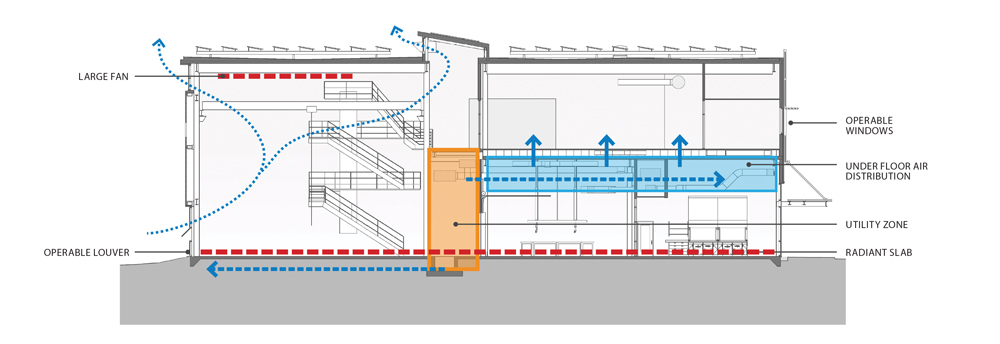Georgia Tech always intended its new energy science facility to be a sustainable building. The project was envisioned as a living lab, embodying the high performance goals that would be explored by the researchers inside. The school needed an adaptable space to accommodate unknown users, scientific techniques, and equipment. A fairly simple high-bay box was the initial plan.
Midway through schematic design, the client heard about a promising construction-grant competition being run by the National Institute of Standards and Technology. Tech halted its project and applied for a grant with the active assistance of its design-build team, including
architect/engineer HDR Inc. and construction manager Gilbane Building Co. The process delayed the job by a year but eventually added $11.6 million to the budget, allowing the school to shoot for a net-zero facility worthy of the name “Carbon-Neutral Energy Solutions Laboratory.”
NIST’s stipulations required the team to adopt a more fast-track, “IPD-light” approach, but also encouraged a more ambitious design. Because all significant team members had been hired early, relationships were already well-established, making a freewheeling exchange of ideas more fruitful.
The shop-like, flexible high-bay lab space accommodates industrial-scale fabrication experiments. Accessible utility trenches in the slab allow unobstructed operation of the industrial crane.
“The original thought was that this would be a low-tech building done fairly quickly, flexibly, and inexpensively,” says HDR Design Principal Dan Rew, AIA. “But when the project became more ambitious, Georgia Tech became the driver for an attempt at net-zero. The campus already had a lot of sustainable projects, which helped. Our discussions with Gilbane about constructability, and their previous efforts at creating energy-efficient buildings, including some net- zero projects they were already working on, also helped.”
In addition, Georgia Tech’s Director of Capital Planning and Space Management, Howard S. Wertheimer, FAIA, LEED AP, was an unusually well-informed and imaginative decision maker. In previous work as a private-sector architect, Wertheimer had designed many complex science buildings himself.
“We already had several science buildings on campus, and because I personally had done many others around the country, there was already a high level of understanding about what this project needed to be,” he says. “This project offered a good opportunity to push the upper limit, and Dan and [Gilbane’s project manager] Paul Stewart brought us some broader perspectives.” Wertheimer also credits valuable input from Tech’s Planning and Design Commission, consisting of external architects and landscape architects who visit the campus quarterly.
Upgrading the plan to achieve more versatile performance
Eventually the team agreed that the project would benefit from a revised program, not just more sophisticated sustainability tactics. Three space typologies were developed: the original high-bay “box” for industrial-scale work; mid-bay labs for science requiring smaller equipment but more stringent environmental control; and office-like computational labs, stacked above the mid-bay labs. This versatility would allow the school to tackle a wide range of projects, including work in combustion, gasification, biochemical-enzymatic conversion of biomass, and CO2 capture.
The Building Team developed specs for temperatures, humidity levels, and ventilation for each lab type, favoring passive design where possible. Under-floor air distribution and radiant slab heating proved useful, and the 9,000-sf high-bay space is not air-conditioned—a bold move in Atlanta.
Features that helped the facility achieve net-zero design and LEED Platinum certification: 1) PV arrays; 2) clerestory windows; 3) light louvers; 4) ceiling fan; 5) radiant slab heating; 6) a shared utility zone; 7) under-floor air distribution; 8) translucent Kalwall cladding; 9) operable windows; 10) permeable concrete; and 11) operable louvers.
“We were willing to take some risks,” says Wertheimer. “If in the future the space becomes too uncomfortable, we have made provisions so we can add air conditioning. But in general, we were willing to take some internal risks to explore new ideas.”
The building’s initial energy baseline was modeled at 147 kBtu/sf/year: drastically less than the 200 to 400 kBtu typical for research labs. Passive design and selected energy-efficiency strategies ultimately reduced that number to 70 kBtu/sf/year. Crucial to making the numbers work: crystalline PV panels installed on the roof, a south-facing wall, and a parking canopy, with an anticipated electrical output of 388,000 kWh/year. This contribution represents 56% of the building’s expected electrical demand, and 26% of the overall baseline energy demand.
Team strategies that helped produce a successful project included:
• BIM. The client’s highest ever Level of Development with BIM, LOD 500, was selected. The model was used not only to guide design but also for project management, clash detection, and shop drawing review and preconstruction meetings. Georgia Tech took advantage of the Building Team’s expertise to develop a campuswide BIM execution plan during the project.
• Interactive scheduling. Gilbane and its subcontractors met weekly in a field office for updates, benefitting from implementation of a 4-D Navisworks scheduling platform and regular use of a three-week “look ahead” schedule and milestones.
• Energy modeling. Various mechanical system options were rigorously analyzed for life cycle cost ramifications. For instance, the Building Team compared a high-efficiency, magnetic-bearing chiller with a ground-source heat exchange system. They rejected the ground-source system, which cost $500,000 more, after modeling revealed that it was slightly less energy-efficient. The cost-benefit profiles of forced natural ventilation, an enthalpy wheel, a night setback for HVAC, and daylighting controls all were verified before systems were approved; insulated translucent exterior panels didn’t make the cut.
• Lean principles. Gilbane’s chief estimator came on board early and used real-time cost models as the design progressed, giving HDR continuous feedback. This procedure reduced the need for drastic value engineering during later stages. Says Gilbane’s Stewart, “We were at the HDR office three or four times a week, seeing where the design was going and keeping the pricing on track. That made the ultimate buyout a lot easier. We avoided a slowdown in VE, which is something that can kill a project.”
In the mid-bay labs, transparent garage-type doors allow experiments to be moved in and out. Overhead utility infrastructure keeps floor space and lab benches unencumbered.
A year after occupancy, the facility is tracking extremely well on its energy-use estimates, says Wertheimer. “Part of that is because we still don’t have really heavy plug loads,” he explains. “We’re not yet fully occupied, so the equipment picture is not complete, but we expect the increase in energy use will be significant. In any event, we’ll be in a much better place than we would have been if we’d created a more conventional building.”
The project has garnered numerous state and national awards, including High Honors in R&D Magazine’s 2013 Laboratory of the Year competition. Team members have made many presentations at professional conferences, helping to ensure that the lessons learned will resonate beyond Atlanta.
Rew concludes, “There are a lot of ideas here that Tech has explored in other places around the campus and pulled together in this project. Not just in energy efficiency, but also in material selection, site use, water retention—just doing the right thing across the board. It’s a LEED Platinum project, but I don’t think Tech was just shooting for a LEED goal. Doing a building like this is a lot more fun than just chasing LEED points.”
Careful planning makes the most of passive ventilation and reduces energy demand. Sustainable strategies are documented and tracked through a “dashboard” display in the lobby, which helps students understand various metrics (energy use, PV generation, ambient air temperature, lighting levels, water consumption).
Project summary
PLATINUM AWARD
Georgia Tech Carbon-Neutral Energy Solutions (CNES) Laboratory
Atlanta
BUILDING TEAM
Submitting firms: Gilbane Building Co. and HDR Inc. (design-build team)
Owner: Georgia Tech
Structural: Ksi/Structural Engineers
MEP/civil: HDR
Energy modeling: EMO Energy Solutions
GENERAL INFORMATION
Project size: 42,000 sf
Construction cost: $22.4 million
Construction time: May 2011 to July 2012
Delivery method: Design-build
Related Stories
Student Housing | Apr 19, 2024
$115 million Cal State Long Beach student housing project will add 424 beds
A new $115 million project recently broke ground at California State University, Long Beach (CSULB) that will add housing for 424 students at below-market rates. The 108,000 sf La Playa Residence Hall, funded by the State of California’s Higher Education Student Housing Grant Program, will consist of three five-story structures connected by bridges.
Construction Costs | Apr 18, 2024
New download: BD+C's April 2024 Market Intelligence Report
Building Design+Construction's monthly Market Intelligence Report offers a snapshot of the health of the U.S. building construction industry, including the commercial, multifamily, institutional, and industrial building sectors. This report tracks the latest metrics related to construction spending, demand for design services, contractor backlogs, and material price trends.
MFPRO+ New Projects | Apr 16, 2024
Marvel-designed Gowanus Green will offer 955 affordable rental units in Brooklyn
The community consists of approximately 955 units of 100% affordable housing, 28,000 sf of neighborhood service retail and community space, a site for a new public school, and a new 1.5-acre public park.
Construction Costs | Apr 16, 2024
How the new prevailing wage calculation will impact construction labor costs
Looking ahead to 2024 and beyond, two pivotal changes in federal construction labor dynamics are likely to exacerbate increasing construction labor costs, according to Gordian's Samuel Giffin.
Healthcare Facilities | Apr 16, 2024
Mexico’s ‘premier private academic health center’ under design
The design and construction contract for what is envisioned to be “the premier private academic health center in Mexico and Latin America” was recently awarded to The Beck Group. The TecSalud Health Sciences Campus will be located at Tec De Monterrey’s flagship healthcare facility, Zambrano Hellion Hospital, in Monterrey, Mexico.
Market Data | Apr 16, 2024
The average U.S. contractor has 8.2 months worth of construction work in the pipeline, as of March 2024
Associated Builders and Contractors reported today that its Construction Backlog Indicator increased to 8.2 months in March from 8.1 months in February, according to an ABC member survey conducted March 20 to April 3. The reading is down 0.5 months from March 2023.
Laboratories | Apr 15, 2024
HGA unveils plans to transform an abandoned rock quarry into a new research and innovation campus
In the coastal town of Manchester-by-the-Sea, Mass., an abandoned rock quarry will be transformed into a new research and innovation campus designed by HGA. The campus will reuse and upcycle the granite left onsite. The project for Cell Signaling Technology (CST), a life sciences technology company, will turn an environmentally depleted site into a net-zero laboratory campus, with building electrification and onsite renewables.
Codes and Standards | Apr 12, 2024
ICC eliminates building electrification provisions from 2024 update
The International Code Council stripped out provisions from the 2024 update to the International Energy Conservation Code (IECC) that would have included beefed up circuitry for hooking up electric appliances and car chargers.
Urban Planning | Apr 12, 2024
Popular Denver e-bike voucher program aids carbon reduction goals
Denver’s e-bike voucher program that helps citizens pay for e-bikes, a component of the city’s carbon reduction plan, has proven extremely popular with residents. Earlier this year, Denver’s effort to get residents to swap some motor vehicle trips for bike trips ran out of vouchers in less than 10 minutes after the program opened to online applications.
Laboratories | Apr 12, 2024
Life science construction completions will peak this year, then drop off substantially
There will be a record amount of construction completions in the U.S. life science market in 2024, followed by a dramatic drop in 2025, according to CBRE. In 2024, 21.3 million sf of life science space will be completed in the 13 largest U.S. markets. That’s up from 13.9 million sf last year and 5.6 million sf in 2022.





















